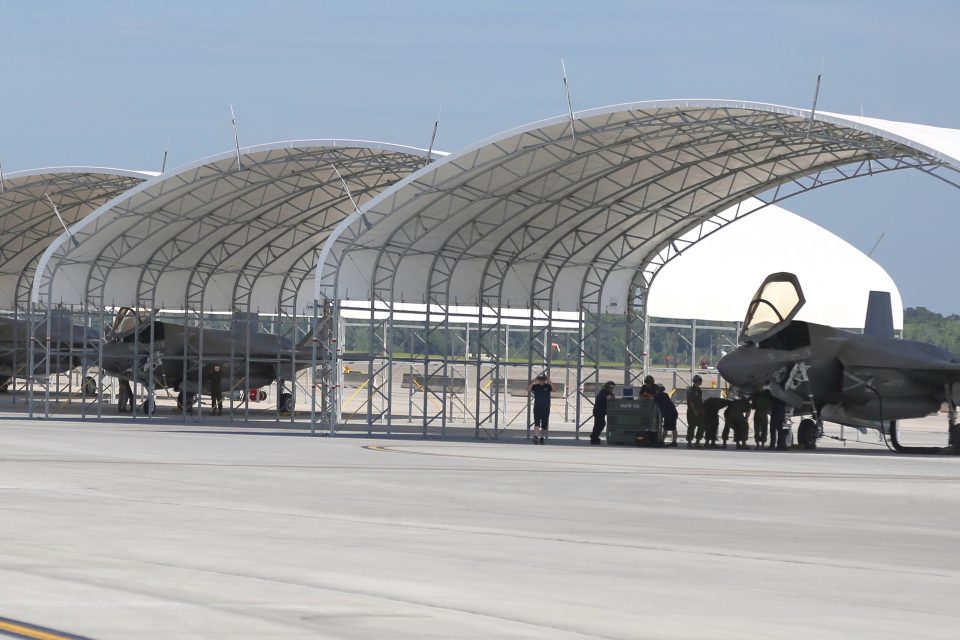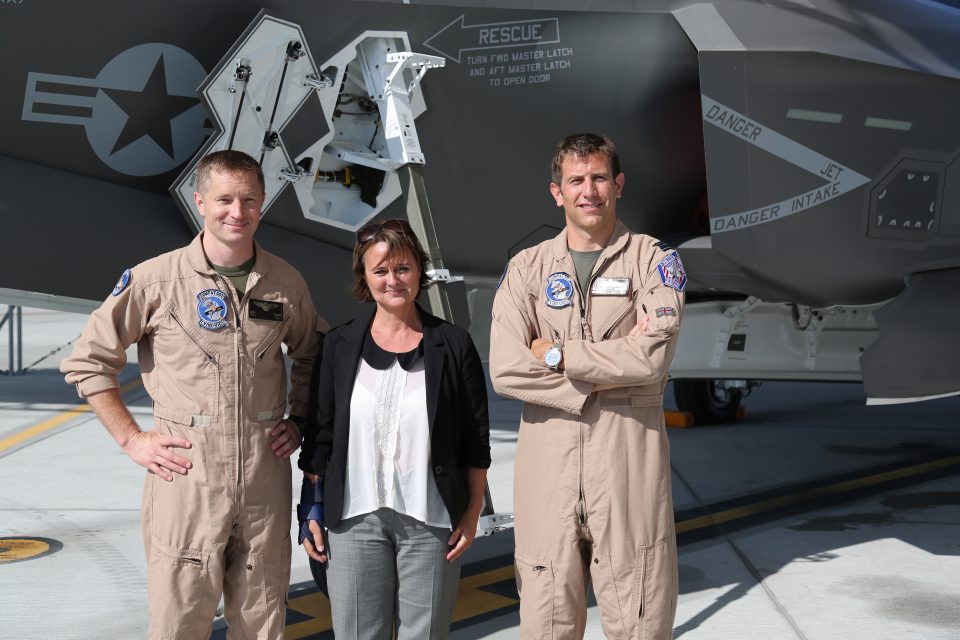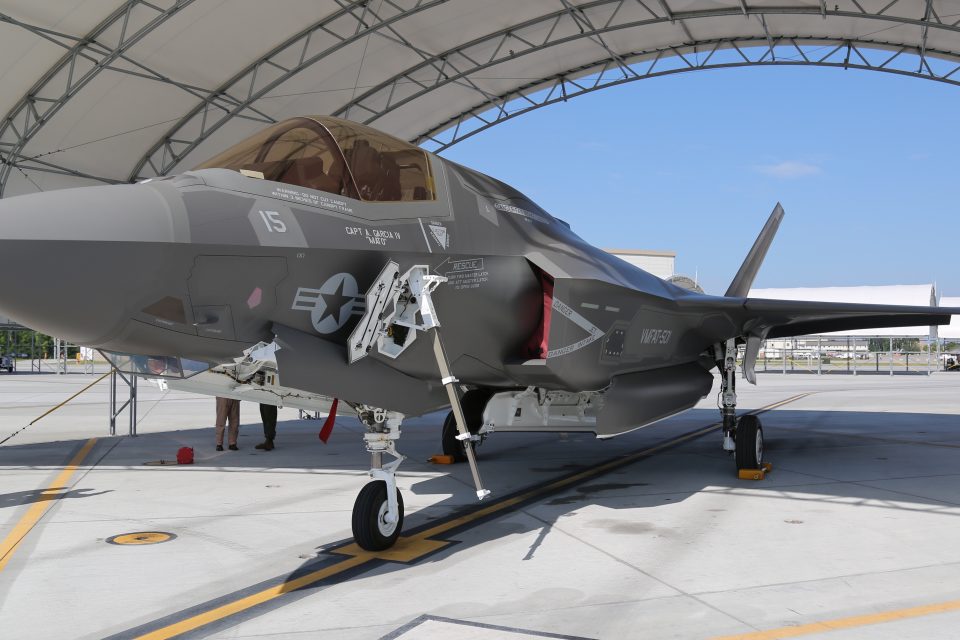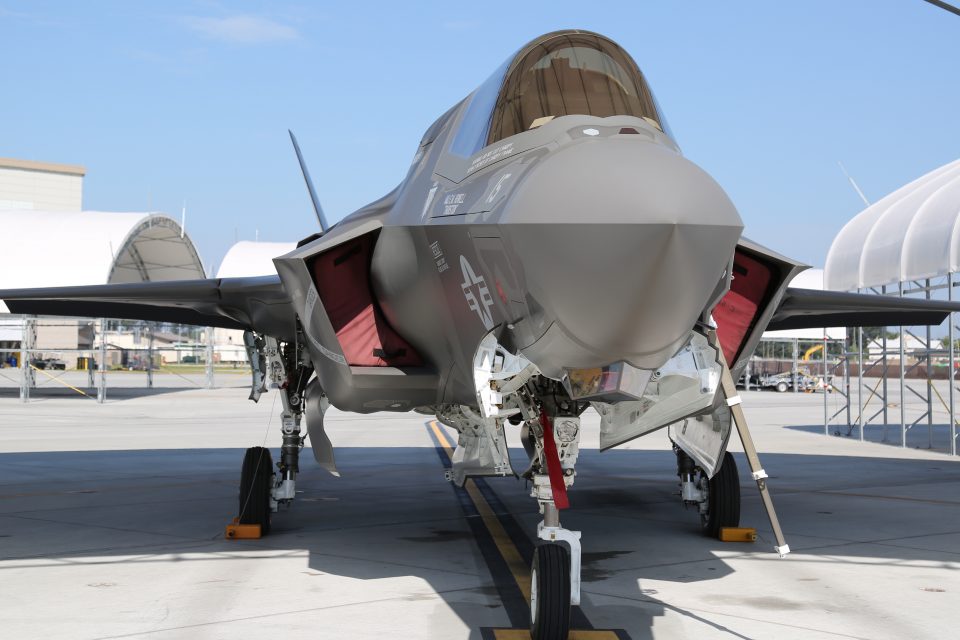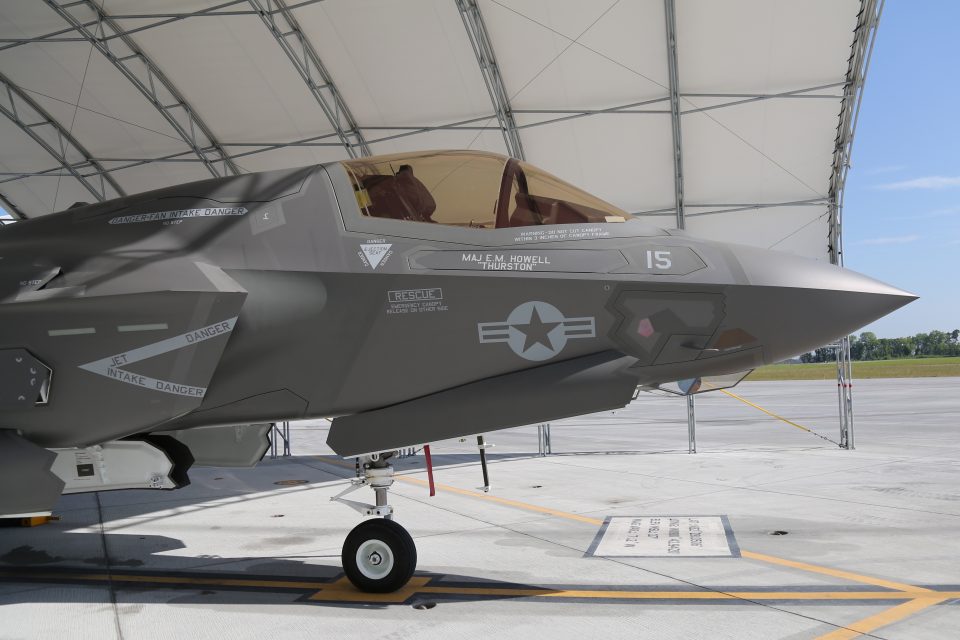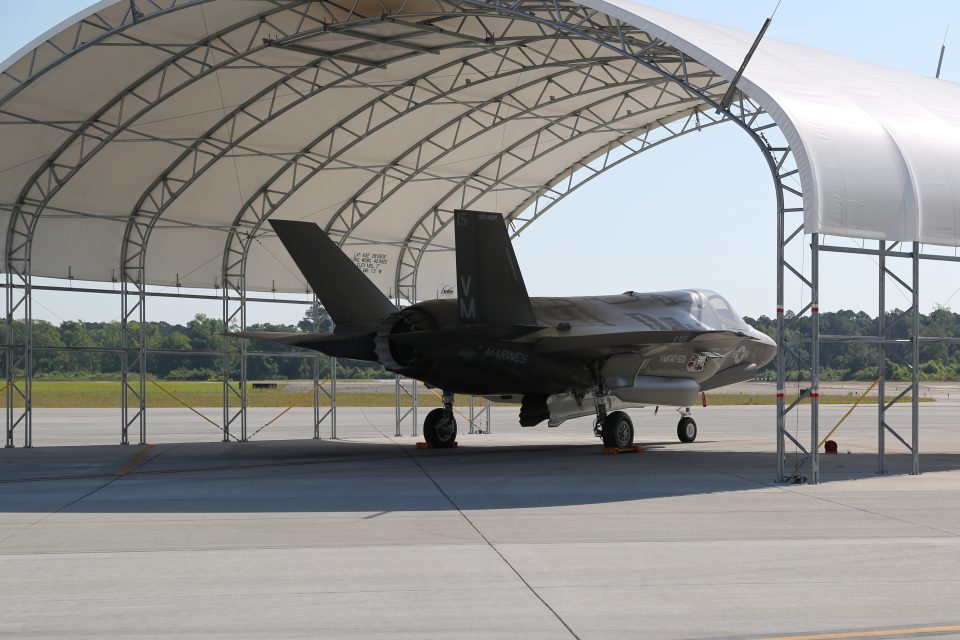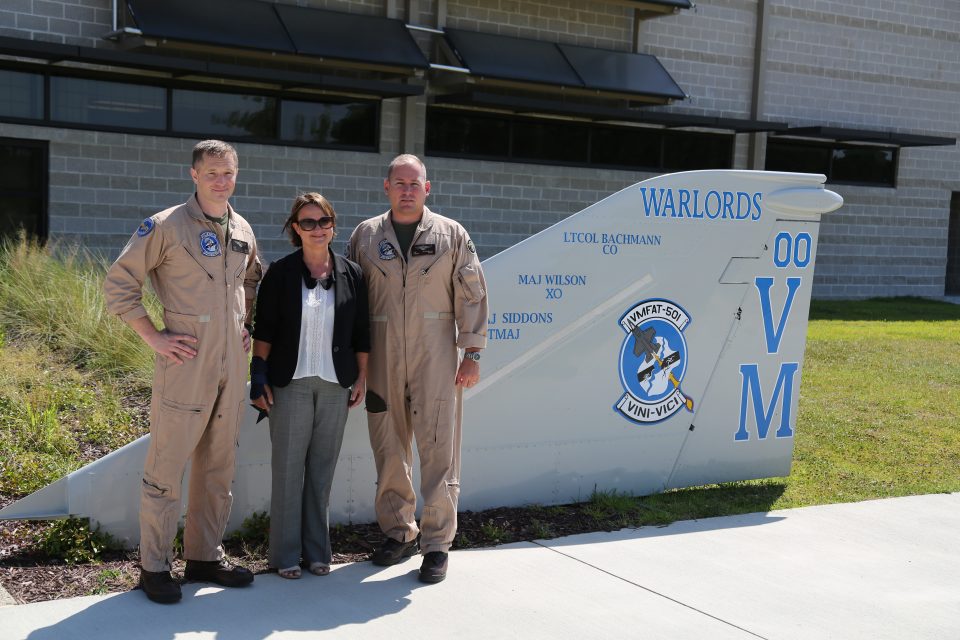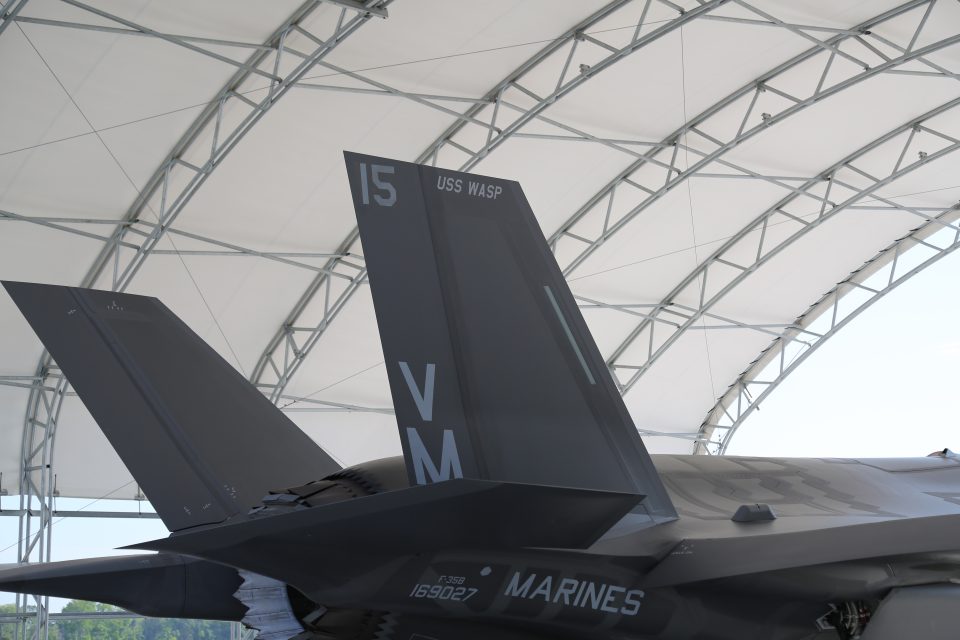2015-09-27 By Robbin Laird
Earlier I have visited the Queen Elizabeth and discussed the initial approach to shaping a cross-modernization strategy for the Royal Navy and the Royal Air Force.
The SLD team has visited the RAF based at Beaufort USMC Air Station and talked with the team there about the working approach with the USMC in shaping the standup of the initial F-35B squadrons.
And onboard the USS WASP during the recent sea trials, Brits and Americans worked together on the ship integration trials.
What is often missed is that the F-35B coming to the carrier or the large deck amphibious ship is not just about the airplane, it is about the evolving combat air system which the integration of the ship and the strike/ISR/C2 aircraft brings to the force.
During my visit to the United Kingdom in September 2015, I have had a chance to discuss with the Royal Air Force two key elements of their fighter transition, the coming of the F-35 and the modernization of the Typhoon, and their interaction with one another.
In this piece, the focus is on the F-35 part of the equation but given the background of the person interviewed that interactivity is built into his operational thinking.
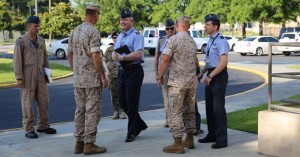
In London, on September 18, 2015, I had a chance to talk with Group Captain Ian Townsend, the replacement for Group Captain Godfrey, and a key officer involved in working the F-35 introduction into service for the RAF.
He is an experienced Typhoon pilot and has been involved with the dynamics of dealing with the Russians in protecting UK airspace as well in the Baltic Air Patrols for NATO.
He has also been involved in working with the Japanese and bringing to the Japanese an understanding of Typhoon and UK thinking about the introduction of the F-35 to the force.
This is another aspect of the allies working together to think through the evolution of 21st century airpower.
Question: You are working the task of bringing the F-35B to the UK in 2018 and preparing for its integration with the Queen Elizabeth.
What role does your engagement with the Marines at Beaufort play in this process?
Group Captain Townsend: We have a pooling implementation agreement or PIA with the Marines.
The PIA formalizes how we’re going to work alongside them. We currently have 14 maintainers at MCAS Beaufort but, by the end of 2018, we’ll have about 242 maintainers.
They are all operating under the U.S. Marine Corps regulations and will be ready to come back to the U.K. and operate F-35 independently in late 2018.
(When visiting MCAS Beaufort Group Captain Paul Godfrey commented: “Without the Marines, the F-35 program would not be where it is today.”)
Question: And concurrently, you are building your own infrastructure in the UK to then support your F-35s in the UK?
Group Captain Townsend: That is correct.
It is a massive effort to put in place the UK infrastructure but we are learning significant lessons from other F35 partner nations.
We are conducting developmental test flying, operational test flying and frontline flying all at the same time, something we call concurrency.
We’ve never done that before.
If we hadn’t taken that approach, none of the F-35 operators would be where we are right now.
The Marine Corps wouldn’t be IOC, if they haven’t taken that approach.
And we certainly wouldn’t be thinking about IOC in 2018 if we hadn’t taken that concurrency approach.
Working alongside the Marines not only allows exposure to F35 operations through the maintenance department, but our pilots are also working alongside their Marines equivalents.
We’re training to the 501 Operational Conversion Syllabus, so we will now know exactly what the Marines are trained to go and do, which I think will make us better partners in the future as well.
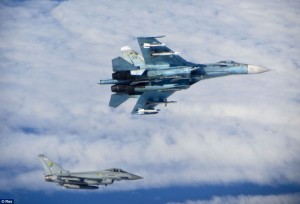
Question: And by then, the Queen Elizabeth will be doing sea trials and getting ready to accept you?
Group Captain Townsend: That is the target.
The first period of developmental testing onboard the Queen Elizabeth happens at the end of 2018.
We have a second period in the mid-part of 2019, and then we will conduct continuation training on the ship before she achieves operational capability at the end of 2020.
Question: One misunderstanding often is that the Royal Navy is seen to be flying the F-35B where it is really the RAF.
And the RAF is flying both the upgraded Typhoon and F-35B and working through their integration.
How would you describe the importance of the RAF working both processes concurrently?
Group Captain Townsend: I think this plays very nicely into the fact that the Royal Air Force is the air-minded service.
We focus solely on being the expert deliverers of air power.
However, being a joint force, we have the additional benefit of having Fleet Air Arm pilots embedded within the U.K. Lightning Force.
So there is no Royal Air Force Lightning Force.
There is no Royal Navy Lightning Force.
We are just one force.
And we’re bringing together the expertise of both elements of light blue and dark blue uniforms to provide the very best effect for carrier strike in the future.
Question: It was clear looking at reactions to the USS Wasp sea trials, that the core point of the integration of the ship with the airplane was largely missed.
The Queen Elizabeth is a ship designed for the F-35B and the F-35B will provide unique capabilities which the ship can capitalize on in shaping its concept of operations.
How would you describe this synergistic process?
Group Captain Townsend: As an airman, I like anything that enhances my ability to deliver air power, and the ship certainly does that.
The ship has been tailor-made from first principles to deliver F-35 operational output.
The ship is part of the F35 air system.
I think this is the key change to where we were in Joint Force Harrier where the ship was really just a delivery vehicle.
The ship was just a runway.
The Queen Elizabeth class aircraft carriers are much more than that.
They are right at the heart of the air system’s capability fundamentally enabling and supporting what the air vehicle is doing three, or four, or five hundred miles away from the ship.
And that wasn’t quite the same in Joint Force Harrier with the Invincible Class CVS carriers.
So it’s very different for us.
Everyone involved in embarked F-35 operations needs to understand what the air vehicle is going off to do because everybody on the ship is much closer to that end delivery of effect.
This is a very different concept of operations from 15 years ago.
When I launched from the CVS in 2005 to fly an operational misison in Afghanistan, once I left the deck, I was gone.
The next contact I would have with the ship was when I called for recovery, several hours later.
Whilst I was airborne the ship and I became very separate operational platforms.
When a UK Lightning launches from the QUEEN ELIZABETH, the information link between the air vehicle and the ship now means that they remain connected during the operation greatly enhancing operational capability.
In terms of being an information node or a C2 node, we’re in a much different place now.
And I think that’s really quite interesting for us as air commanders in terms of our ability to control what is going on forward with the airplanes.
I also think from a pilot’s perspective, being on the deck in my F-35, being able to see in my cockpit what is going on in the battle space, because my brothers in their F-35s already in the operational battlespace have sent information back to me, I think that’s really exciting as well.
We are no longer launching into the unknown.
We can see what’s happening.
We understand what we’re going off to go and do, but we can see the real-time situation in the battle space before we launch off the deck.
This is a significant operational benefit..
Question: The impact of the global fleet of F-35s is significant as well in shaping enhanced capability for the Queen Elizabeth-F-35 enabled air system as well.
How do you see the impact of the F-35 global enterprise on the RAF?
Group Captain Townsend: There are many benefits.
Not just in terms of training alongside each other and seeing the TTP developments, but practically when you’re in the battle space, how much information can you get from all of these different F-35 partners that are out there.
Broadening that question a little bit further, being part of the global platform and global sustainment, what are the opportunities there about not having to take all logistics with you?
What can you do to leverage off an Italian ship that’s nearby that might have the particular part that you need but you might not have it because you haven’t had to take anything forwards.
There’s an awful lot of questions being raised and a lot of opportunities available about being part of this global platform.
Again, this is something that we in the U.K. have never done before and there are a number of lessons ahead.
Question: I believe that any new platform needs a decade to put its legs under it.
But the basic point is that we’re moving in a different direction from the beginning, rather than spinning our wheels with historic patterns.
And your perspective is the need to get on with it, more or less?
Group Captain Townsend: I think that’s absolutely right and inevitable.
But at least, the foundation has been set.
The partners involved in the global platform understand each other’s business, from the outset, in a way that we haven’t really seen ever before.
I think the closest equivalent you could come to would be the F-16 program that was widely sold across the world, but every nation did F-16 differently.
There were different support solutions for every F-16 operating nation.
By and large, anyone operating F-35 is going to be doing it in broadly the same way with the same sort of broad sustainment solution.
That’s part of the global program. That’s what makes it an attractive option for everyone that’s involved.
Question: How would characterize the role of the F-35 compared to the other elements in the evolving RAF air combat force?
Group Captain Townsend: The F-35 is not a multi-role fighter.
Multi-role, in current thinking, would be a sequential series of tasks.
The F-35 is doing a number of missions simultaneously.
The concept of mission simultaneity is really important.
The airplane has the ability to do things without the pilot asking it to do it.
Automatically conducting, particularly, ISR whilst it’s conducting an OCA mission or an attack mission in a very different way than platforms have done business in the past.
This is something that other operators are working in the package alongside F-35 need to understand.
That the F-35 operator won’t be going through sequential thought process.
He will be thinking about the battle space in a broader sense, a much different way than a Typhoon operator would be thinking about the battle space.
I think there is another step change and difference in the way in which the information is displayed to the pilot which is important and is extremely intuitive.
I’ll give you an example. I commanded a Typhoon squadron for two years.
Very early on this job with F-35, I was lucky enough to fly the F-35 simulator. and the different way in which F35 displays information compared to Typhoon is eye-catching.
In fact, I asked for the simulator to be stopped because I was taken aback by the information being displayed to me.
There was just so much data available at my fingertips, but displayed in a really different sense in Typhoon.
So very, very quickly, I knew a great deal about the entity being targeted – sensor fusion at work.
I think it’s a very different way of displaying information that any other fast jet has done before.
Knowing what my wingman is seeing and my wingman knowing what I am seeing, and my ability to communicate what I want to have achieved by my formation, by my package, which all may be by the air wing that’s air-borne at the time.
This airplane changes the game in a way which we can conduct that sort of business.
Question: What is the potential for the Royal Navy of having you guys on board and of re-thinking where they want to take the development of the surface fleet?
Group Captain Townsend: I think this plays very much into the concpet that ‘Aegis is my wingman’.
I think from a U.K. perspective, Type 45 is my wingman.
The importance there is that the F-35 pilot for the U.K. or for any of F-35 operator, the information he has available to him allows him to make decisions for other operators in the battle space. And that is not simply other operators meaning other airplanes; that is, other operators being air, land, or maritime platforms.
The ability for the F-35 pilot to control the battle space in its entirety means that people operating in the surface fleet, for example, need to understand what the F-35 can achieve.
Because if they don’t, they don’t know what the F-35 pilot is going to ask them to do when they ask them to do it.
So they have to instinctively understand the capability of the airplane, because every, every platform involved in the battle space now is part of what the F-35 air system can deliver in terms of operational effect.
I think the fifth-generation capability sets the context for the battle space.
You have to understand, when you’ve got a capability that is so different in the battle space.
If you cannot connect into it or influence or, or interact with it, your utility and your fourth-generation platform or your surface ship Type 45, is significantly reduced.
Question: Training for the expanded battlespace is a challenge, and the F-35 is part of the evolving training challenge.
The UK has very limited air space in which to train.
How are dealing with this challenge?
Group Captain Townsend: There are number of reasons that make the U.K., I think, unique in its approach to synthetics.
We don’t have access to airspace around the U.K. that allows us to use the full capability of F-35.
For security reasons, we wouldn’t want to expose the full capability of F-35.
And we also lack some of the threats, some of the high-end surface-to-air missile threats, for example, that we want to train against.
All of this forces us into the synthetic environment which is not a scary place for the U.K. fleet because the Typhoon force has been exploiting synthetics now aggressively for the last couple of years.
Now the peculiar thing for the U.K. is the closer we get to conducting a warfighting operation, the more we will fly the simulator rather than the live airplane.
And if I was to put that premise to any USAF pilot or U.S. Marine Corps pilot, they would look at me cock-eyed.
But it’s the only way we can train at the high-end.
Fortunately, we’ve already got capability demonstrated and we’ve been using this for the last five or six years at RAF Waddington where we’ve got a joint synthetic environment that allows us to connect Type 45 to Typhoon to E3 with a joint flight simulator so we can conduct CAS for the fire support team.
That technology is already proven.
What we need to do now is take the next step which is introduce the higher security capable F-35 into the lower security environment of Typhoon and E3. Again, not impossible, proven through scientific programs, what you need to know is make our frontline service capability.
But synthetic training is, is something that we’re looking at extremely closely because it’s the only way we’re going to get operational capability from the F-35.
We can’t do it live in the U.K.
Question: There clearly are major shifts underway with regard to command and control under the impact of fifth generation warfighting approaches.
How do you view this dynamic?
Group Captain Townsend: In the legacy case such as my operations in Iraq and Afghanistan and the Balkans with Harrier, I was told to go to a particular place with a particular weapon load to conduct a specific task at a certain time, even told which direction to fly sometimes to drop my ordinance.
We cannot constrain F-35 in that way.
We need to find a way to direct air missions in F-35, that relay the commander’s intent and then allow the pilot in F-35 to assimilate the information he’s presented with to make the decision at the source in line with the commander’s intent.
The air-tasking message and the air-tasking order at the moment, is not a great vehicle through which to achieve that.
And I think then, we get into the realities of F35 pilots conducting mission command.
There is a danger that the information that could be passed back from the F-35 community in all these F-35 packages back to the CAOC could lead the air command element to be more directive, because they’ve got more information in their CAOC than ever before.
I think that would be a mistake.
The F-35 should give us the confidence to allow the pilot to make more decisions than ever before, but we have to get the commanders intent and this breadth of tasking rather than directive tasking framed in the right way.
Editor’s Note: The practical implications of the analysis provided by the RAF Group Captain for journalists, analysts and GAO types is pretty fundamental: don’t analyze the ship without reference to the plane; and don’t discuss the plane as a replacement platform for together the Queen Elizabeth and the F-35B are a 21st century air system.
We have argued that no platform fights alone, and clearly this true for the Queen Elizabeth.
In the photo below a Japanese officer participating in joint training with the RAF as seen in a 2014 visit.
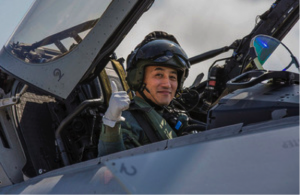
Officer from 201st Tactical Fighter Squadron give the thumbs up at RAF Coningsby
Japanese Air Self Defence Force officers has visited 3 (Fighter) Squadron at RAF Coningsby in what is the second visit between the two squadrons following the RAF officers visit to Japan last year.
During their stay, 3 Japanese officers, from the 201st Tactical Fighter Squadron (TFS) based at Chitose Air Base, on the Northern Japanese island of Hokkaido, have been shown how the RAF uses the Typhoon in its operational capacity as well as gaining an understanding of the synthetic training used by Typhoon pilots.
Wing Commander Cab Townsend, Officer Commanding 3 (Fighter) Squadron said: Our approach to QRA and the challenges we have faced in the Baltic region have many parallels to how the Japanese perform similar operational activity.
Credit Photos in the Slideshow Above: Second Line of Defense
- The first few shots show some of the F-35s at the squadron during the May visit, including one with Wasp markings that was prepared to join OT-1.
- The sixth photo shows Squadron Leader Nichols in front of a UK F-35. Even though he is standing in front of the plane, within the squadron any squadron member might fly this plane, as will the Brits fly USMC jets. This is the same as at Luke where the Aussies and the USAF pilots fly each other’s planes. This is part of the F-35 global enterprise already being stood up.
- The seventh and eighth photos show Murielle Delaporte with Squadron Leader Nichols and Major Brian Bann.
- The final photos show Lt. Col. Bachmann and Major Bann with Murielle Delaporte and Robbin Laird in front of the Warlords squadron building.
For additional pieces on the coming of the Queen Elizabeth carrier see the following:
http://www.indiastrategic.in/topstories3766_A_Tale_of_Three_Carriers.htm
http://frontline-defence.online/article/2015/4/2149
https://sldinfo.com/the-new-uk-aircraft-carrier-reshaping-the-royal-navy-and-the-royal-air-force/
https://sldinfo.com/preparing-the-f-35b-for-hms-queen-elizabeth-ski-jump-testing/
https://sldinfo.com/the-royal-air-force-and-the-f-35-shaping-an-airpower-transition/


